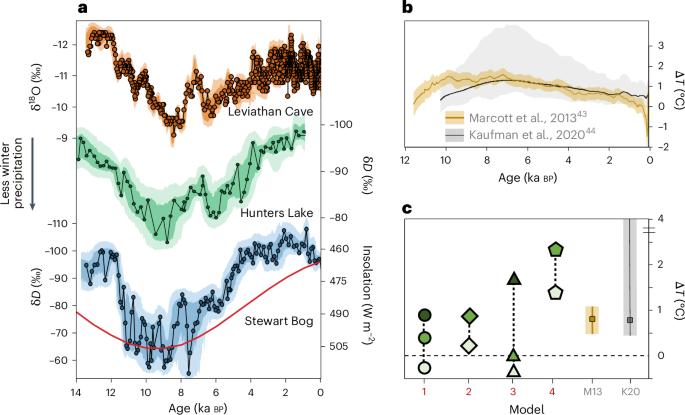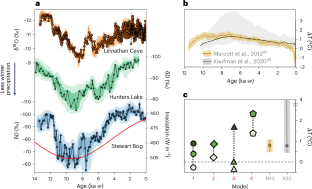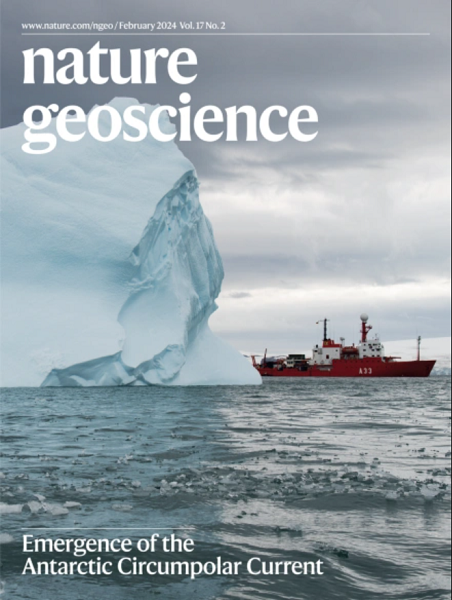北太平洋海洋-大气对全新世和未来变暖的响应导致美国西南部干旱
IF 16.1
1区 地球科学
Q1 GEOSCIENCES, MULTIDISCIPLINARY
引用次数: 0
摘要
美国西南部正在经历严重而持续的干旱,尽管其原因的不确定性限制了我们预测水供应变化的能力。当前干旱的严重程度归因于气候变暖和大气环流的自然变化,这表明当前的降雨不足可能会随着自然振荡的逆转而改善。在这里,我们使用新的叶蜡稳定同位素重建和模拟中全新世(6000年前),并证明北半球的适度变暖可以通过源自北太平洋的海洋-大气响应在美国西南部产生干旱。海洋变暖和降雨变化的模式类似于太平洋年代际涛动的负相,表明这种模式可以被外部强迫激发。在未来的预测中,对变暖的类似反应也很明显,导致整个21世纪中期持续的冬季降水不足。然而,与北太平洋响应相关的过去和当前降水亏缺量在模式中被系统地低估了,这可能是由于海洋-大气相互作用的弱耦合。预测也可能低估了这种降水对北太平洋变化的响应程度,从而导致这个已经缺水的地区面临更大的干旱风险。本文章由计算机程序翻译,如有差异,请以英文原文为准。


North Pacific ocean–atmosphere responses to Holocene and future warming drive Southwest US drought
The Southwest United States is experiencing severe and persistent drought, although uncertainties regarding the causes limit our ability to predict changes in water availability. The severity of the current drought has been attributed to a combination of warming and natural changes in atmospheric circulation, suggesting that current rainfall deficits may improve as natural oscillations reverse sign. Here we use new leaf-wax stable isotope reconstructions and simulations for the mid-Holocene (6 thousand years ago) and demonstrate that moderate warming of the Northern Hemisphere can produce drought over the Southwest United States through an ocean–atmosphere response originating in the North Pacific. The patterns of ocean warming and rainfall change resemble the negative phase of the Pacific Decadal Oscillation, indicating that this mode can be excited by external forcings. A similar response to warming is evident in future projections, leading to sustained winter precipitation deficits through the mid-twenty-first century. However, the magnitudes of past and current precipitation deficits associated with this North Pacific response are systematically underestimated in models, possibly due to a weak coupling of ocean–atmosphere interactions. Projections may also underestimate the magnitude of this precipitation response to changes in the North Pacific, leading to greater drought risk in this already water-poor region. Mid-Holocene and the future warming induces a North Pacific response resulting in sustained winter precipitation deficits and drought over the Southwestern United States, according to new palaeoclimate data and climate model simulations.
求助全文
通过发布文献求助,成功后即可免费获取论文全文。
去求助
来源期刊

Nature Geoscience
地学-地球科学综合
CiteScore
26.70
自引率
1.60%
发文量
187
审稿时长
3.3 months
期刊介绍:
Nature Geoscience is a monthly interdisciplinary journal that gathers top-tier research spanning Earth Sciences and related fields.
The journal covers all geoscience disciplines, including fieldwork, modeling, and theoretical studies.
Topics include atmospheric science, biogeochemistry, climate science, geobiology, geochemistry, geoinformatics, remote sensing, geology, geomagnetism, paleomagnetism, geomorphology, geophysics, glaciology, hydrology, limnology, mineralogy, oceanography, paleontology, paleoclimatology, paleoceanography, petrology, planetary science, seismology, space physics, tectonics, and volcanology.
Nature Geoscience upholds its commitment to publishing significant, high-quality Earth Sciences research through fair, rapid, and rigorous peer review, overseen by a team of full-time professional editors.
 求助内容:
求助内容: 应助结果提醒方式:
应助结果提醒方式:


